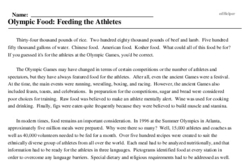Olympic Food: Feeding the Athletes
Thirty-four thousand pounds of rice. Two hundred eighty thousand pounds of beef and lamb. Five hundred fifty thousand gallons of water. Chinese food. American food. Kosher food. What could all of this food be for? If you guessed it's for the athletes at the Olympic Games, you'd be correct.
The Olympic Games may have changed in terms of certain competitions or the number of athletes and spectators, but they have always featured food for the athletes. After all, even the ancient Games were a festival. At the time, the main events were running, wrestling, boxing, and racing. However, the ancient Games also included feasts, toasts, and celebrations. In preparation for the competitions, sugar and bread were considered poor choices for training. Raw food was believed to make an athlete mentally alert. Wine was used for cooking and drinking. Finally, figs were eaten quite frequently because they were believed to build muscle and stamina.
In modern times, food remains an important consideration. In 1996 at the Summer Olympics in Atlanta, approximately five million meals were prepared. Why were there so many? Well, 15,000 athletes and coaches as well as 40,000 volunteers needed to be fed for a month. Over five hundred recipes were created to suit the ethnically diverse group of athletes from all over the world. Each meal had to be analyzed nutritionally, and that information had to be ready for the athletes in three languages. Pictograms identified food at every station in order to overcome any language barriers. Special dietary and religious requirements had to be addressed as well. Even portable lunches were prepared for athletes who could not make it to the dining hall; they were known as Olympic lunch boxes. Do you remember those statistics of food at the beginning? That was only the beginning. There was also 70,000 gallons of milk, 52,000 pounds of pasta, and 23,342 pints of strawberries. What were the most popular foods? At the Atlanta Games, the athletes made pasta and fresh fruit the most popular choices.




